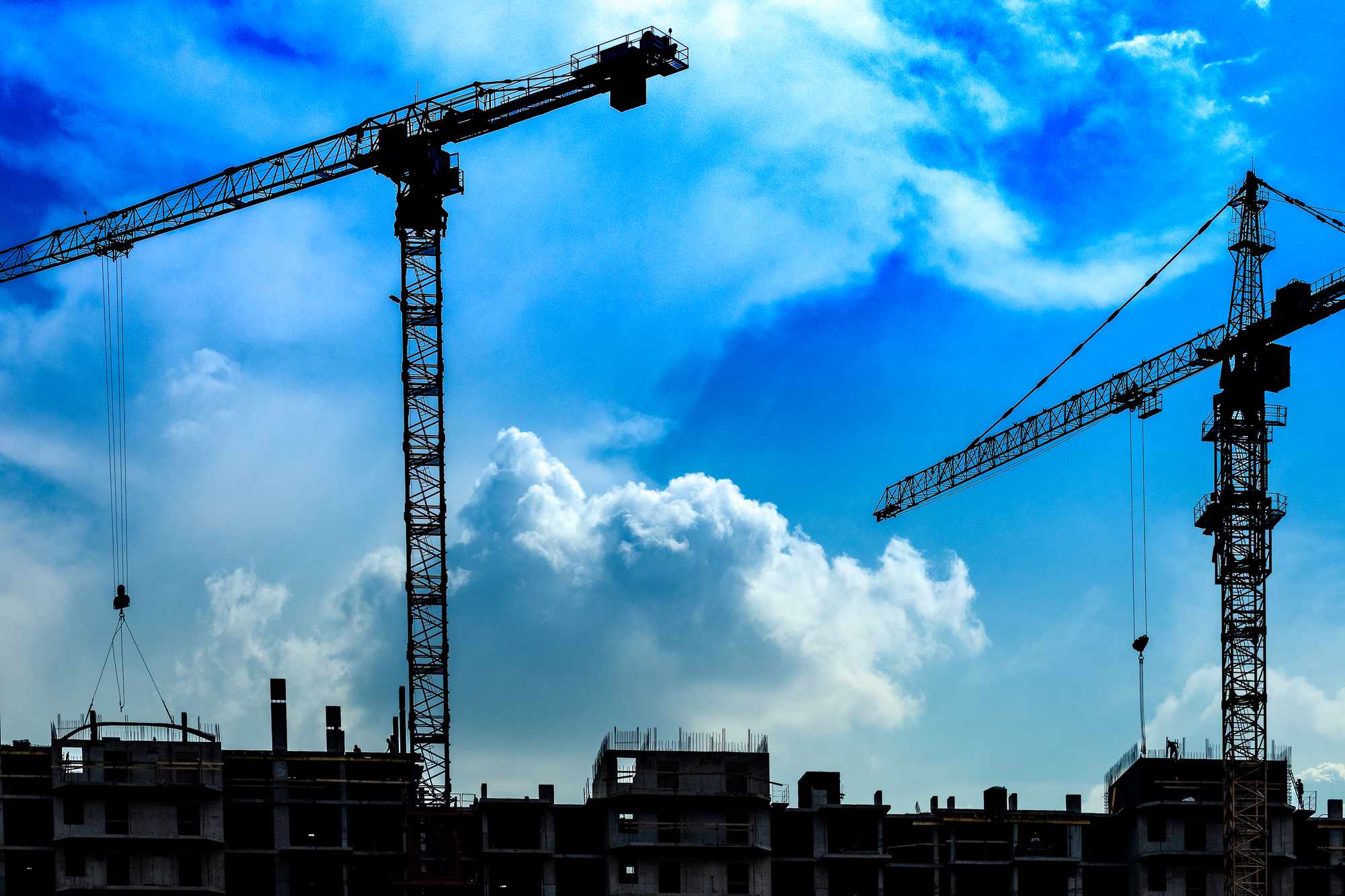The construction industry is constantly evolving, and staying up-to-date on current construction industry statistics can help your business remain competitive.
These insights not only reveal trends but also provide a clearer picture of the challenges and opportunities that construction contractors are facing.
This page dives into some of the latest numbers shaping construction.
1. U.S. Construction Spending Grew 5% in 2023 Compared to a 12% Growth in 2022
While growth slowed from 12% in 2022 to 5% in 2023, the continued upward trend in construction spending reflects a resilient industry.
2. Private Sector Construction Spending Made Up 79% of Industry Spending in 2022
Private sector projects dominated U.S. construction spending in 2022, making up 79% of the total $1.43 trillion.
3. Multifamily Construction Rose by 18% in 2023
Multifamily residential construction saw significant growth in 2023 but is projected to slow down by 7% in 2024, reaching $131 billion.
4. Single-Family Construction Decreased by 13% in Q4 of 2023
Single-family construction faced a 13% decline in quarter 4 of 2023. With this sector facing challenges, expanding into multi-family construction could be beneficial for maintaining revenue streams.
5. Commercial Construction Spending Hit $128 Billion as of July 2023, Up 11% from 2022
The 11% rise in commercial construction spending reflects a continued push for business and infrastructure development.
6. Home Improvement Spending Grew 1% in 2023
While modest, the 1% increase in home improvement spending signals consistent interest in home upgrades. For construction companies that offer residential renovations, small but stable growth is an opportunity for consistent project flow.
7. Office Construction Spending Increased by 8% in 2023 Due to Demand for Class A Space
Office construction rose by 8% in 2023, driven by the demand for premium Class A spaces in major urban centers. This shift suggests an opportunity to explore or expand in urban office developments, especially if your team specializes in high-quality commercial projects.
8. Demand for Smart Technologies Is Fueling Office Construction
The push for tech-focused office spaces is expected to drive construction projects in the future. For construction businesses, pivoting to accommodate these demands could position your construction company as a competitive choice in this landscape.
9. Office Construction Declined Sharply in 2024
Office construction declined 67% in 2024, demonstrating the dropping demand for office space as many companies move to remote work.
10. Conservation and Development Construction Valued at $11 Billion
The conservation and development sector, valued at $11 billion, represents an important niche for eco-conscious projects. If you’re considering expanding into conservation, this sector is set for growth that aligns well with sustainability-focused efforts.
11. Sewage and Waste Disposal Construction Rose by 7% in 2023
Spending on sewage and waste disposal projects increased by 7% last year. This area presents reliable opportunities in essential services with a steady demand.
12. Transportation Construction Increased by 9% in 2023
Governments boosted budgets and spending on transportation projects, resulting in a 9% increase in transportation construction in 2023. With infrastructure development a national priority, this trend is likely to continue as states work to improve and expand transit systems.
13. 20% of U.S. Construction Takes Place in Five Cities
New York, Dallas, Houston, Los Angeles, and Washington account for 20% of all construction projects in the United States. This concentration reflects the significant urban development needs in these metropolitan areas and the ongoing demand for new construction in major cities.
14. Conservation and Development Spending Rose by 21% Due to Gulf Coast Restoration
Restoration efforts to protect the U.S. Gulf Coast from storms were a key factor in the 21% increase in conservation and development spending. This investment aims to safeguard cities from extreme weather, bolstering resilience in hurricane-prone regions.
15. New York City Is the World’s Most Expensive City to Build In
In 2023, New York City ranked as the priciest global construction market, with costs reaching $501.78 per square foot. High demand and complex building regulations contribute to these costs, making it a challenging environment for developers.
16. 37% of Construction Companies Used Drones on Job Sites in 2021
Drone technology was in use at 37% of construction companies’ job sites in 2021, aiding in surveying, safety assessments, and project monitoring.
17. Only 3% of Construction Companies Aren’t Using Dedicated Construction Software
Nearly all construction firms now use specialized software, with only 3% reporting not using dedicated software. From project management to digital design, these tools have become ubiquitous for modern construction workflows.
18. 45% of Contractors Declined Projects Due to Skilled Labor Shortages in 2021
A lack of skilled labor led 45% of contractors to turn down projects in 2021, highlighting an industry-wide workforce challenge. Training initiatives and recruitment efforts will be an important part of meeting future construction demands.
19. 97% of Contractors Experienced Material Cost Fluctuations’ Impact on Their Business
Material cost fluctuations had a moderate to high impact on 97% of contractors in 2021, affecting project budgets and timelines. Strategies to manage these costs are critical as volatility in materials pricing continues to influence the industry.
20. Demand for New-Build Home Upgrades Will Continue Long-Term
The market for new-build home upgrades is projected to remain strong.
21. U.S. Construction Equipment Rental Sales Reached $47.8 Billion in 2021
The construction equipment rental market hit $47.8 billion in 2021. Rentals offer flexibility and cost savings.
22. The Tool and Equipment Rental Industry is a $5 Billion Market
In the U.S., tool and equipment rentals are a $5 billion industry, supporting contractors and DIY enthusiasts alike. Rentals provide convenient access to specialized equipment without the burden of ownership costs.
23. Nearly 11.8 Million People Worked in the U.S. Construction Industry in 2022
In 2022, the construction industry employed nearly 11.8 million workers, representing a vital part of the American workforce across residential, commercial, and infrastructure sectors.
24. 57% of Construction Firms Employ Fewer Than 200 Staff Members
The majority of construction firms are smaller businesses, with 57% having under 200 employees. This highlights the prevalence of small- to mid-sized companies in the industry.
25. Construction Managers Earned an Average Annual Salary of $110,160 in 2022
Construction managers in the U.S. earned an average of $110,160 annually in 2022, reflecting the high responsibility and skill required for overseeing projects and managing teams.
26. The Average Hourly Wage for Construction Employees Was $35.21 in January 2024
As of January 2024, the average hourly wage for construction workers stood at $35.21.
27. Median Weekly Earnings for Nonunion Construction Workers Were $1,007 in 2023
In 2023, nonunion construction workers earned median weekly wages of $1,007.
28. Median Weekly Earnings for Union Construction Workers Were $1,424 in 2023
Union construction workers earned median weekly wages of $1,424 in 2023, benefiting from union negotiations that typically result in higher wages and better working conditions.
29. Top 400 U.S. Construction Companies Generated $414.88 Billion in Revenue in 2020
In 2020, the 400 largest U.S. construction firms collectively generated $414.88 billion in revenue, underscoring the financial scale of the industry’s top players and their contributions to the economy.
30. 1.7 Million Searches for Independent Contractors Monthly
Every month, the term “independent contractor” is searched online 1.7 million times. This volume of searches highlights the importance of digital presence for construction contractors aiming to attract clients.
31. Average CPC for Construction Search Ads: $2.56
Construction industry advertisers pay an average of $2.56 per click on search ads. Investing in search ads can be a worthwhile strategy for reaching potential clients actively looking for construction services.
32. Average CPC for Construction Display Ads: $0.54
The average cost-per-click for display ads in the construction industry is $0.54, making it an affordable option for contractors looking to increase visibility and reach a broader audience with visual advertising.
33. 96% of Consumers Discover Local Businesses Online
Nearly all consumers—96%—use the internet to find local businesses, including construction companies. For construction professionals, a strong online presence is very important for attracting leads.
Generate More Leads for Your Construction Business with Local SEO
We hope these statistics provide insights that you can put to work in your business strategy. Whether it’s understanding the online habits of potential clients or recognizing the impact of advertising costs, knowing where the construction industry stands today can help shape your marketing efforts for tomorrow.
If generating more visibility and leads for your business is on your agenda, consider our local SEO services for construction contractors. It’s a service we offer to help businesses like yours connect with local customers who are already searching for what you do best.
If you’d like to learn more, contact us here.
Sources
- https://www.census.gov/construction/c30/pdf/release.pdf
- https://www.statista.com/statistics/226355/us-public-and-private-sector-construction/
- https://fmicorp.com/uploads/media/Q4_Outlook_2023_Final.pdf
- https://fmicorp.com/insights/construction-outlook/2023-north-american-engineering-construction-outlook-third-quarter
- https://fmicorp.com/uploads/media/Overview_2022_Final.pdf
- https://www.newcivilengineer.com/latest/most-expensive-cities-for-construction-revealed-2-26-06-2023/
- https://contechreport.com/wp-content/uploads/2021/12/2021-JBKnowledge-Construction-Technology-Report.pdf
- https://www.uschamber.com/assets/documents/Q4-2021-CCI-Report.pdf
- https://agacad.com/blog/global-bim-survey-u-s-market-is-maturing-as-advances-wake-imaginations
- https://www.washingtonpost.com/transportation/2023/04/28/infrastructure-projects-time-budget/
- https://www.statista.com/statistics/248725/us-equipment-rental-market-size/
- https://www.ibisworld.com/united-states/market-research-reports/tool-equipment-rental-industry/
- https://www.bls.gov/cps/cpsaat18.htm
- https://stats.bls.gov/iag/tgs/iag23.htm#earnings
- https://www.enr.com/articles/51806-enr-top-400-contractors-the-pandemics-second-act
- https://www.uschamber.com/economy/us-chamber-commercial-construction-index-q4-2021
- https://www.constantcontact.com/blog/contractor-leads/


